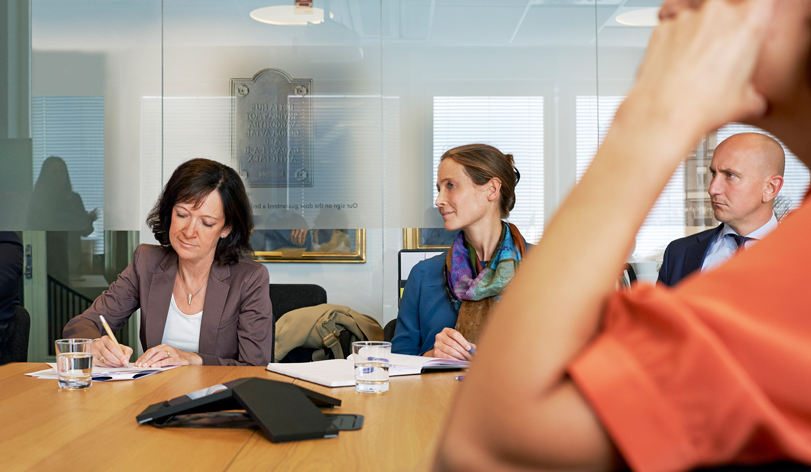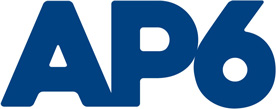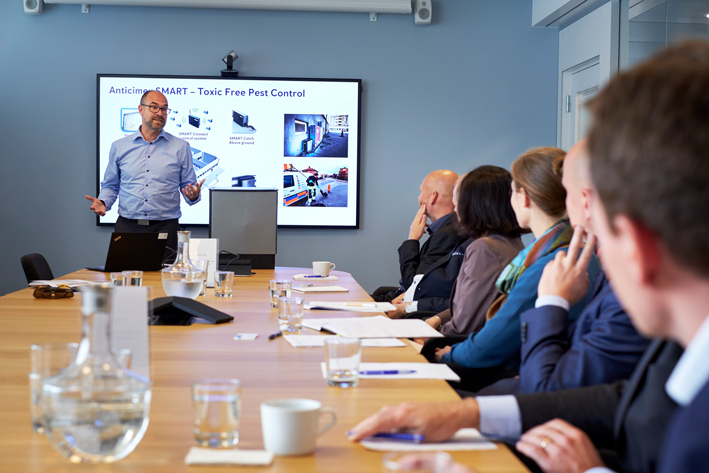Investors discussed sustainability with Anticimex. Each year, AP6 visits some of the companies it has invested in to discuss the topic of sustainability, on site. These discussions supplement other forms reporting and information that is provided.
Ulf Eripe, Chief Technology Officer at Anticimex, explains how the company is using sensors and new technology in modern traps. It gives the company access to a large quantity of data that makes it possible to, with much more accuracy, predict the presence of pests. The digital traps offered by Anticimex have many advantages compared to traditional ones. One advantage is a much lower use of pesticides, which are harmful not only to the pests, but also people and the environment.
Photos: Johan Olsson
Pest control is Anticimex’s core business and the company has identified several challenges and opportunities in the area of sustainability. At the top of the opportunities’ list is lower carbon dioxide emissions, lower use of chemicals and higher diversity among employees. AP6 visited the company and met its main owner, EQT, together with several other investors.
“AP6 has decided to, each year, visit some of the companies it has invested in. We use the opportunity to discuss sustainability, as a supplement to other forms of reporting and information that is provided. Anticimex is a relatively new and large direct investment. So, it’s naturally one of our priorities,” says Anna Follér, Sustainability Manager at AP6.
Anticimex and its main owner, EQT, happily agreed to meet with AP6 and also invited some of its other investors. Anticimex is a global business, with operations in 18 countries. The company has been doing business in Sweden since 1934 and it has become household name. Because it has operations in many countries, sustainability efforts are managed at the Group level, yet also adapted to the local conditions. The approach is to use well-functioning models and methods appropriate to each country and then spread best practice throughout the Group.
That same methodology, the “Anticimex Model” is also what the company has successfully applied over the years to increase sales and provide excellent customer service. With the Anticimex Model, results of the various units are continually monitored. The most successful efforts are identified and spread as best practice throughout the entire organization.
“The Anticimex Model has proven to be successful when it comes to sales and customer service. So, it seems perfectly logical that it can be applied to the area of sustainability as well,” says Vidar Andersch, responsible for AP6’s investment in Anticimex.
For its operations in Sweden, Anticimex has established three concrete goals for sustainability. One focuses on lowering the organization’s carbon dioxide emissions. The aim is to achieve this via better planning and coordination of driving schedules for service vehicles. In some countries, there are also plans to gradually replace the fleet with EVs. In Sweden, the target is to lower carbon dioxide emissions by 20 percent.
Another sustainability goal is to lower the use of chemicals associated with pest control. This can be achieved via the gradual transition to digital traps and other “smart” pest control methods.
“It’s great that Anticimex has set clear, measurable targets for its sustainability efforts. We’re confident that, by focusing on efficient transports and lowering the use of chemicals, Anticimex will be successful in achieving tangible results,” says Margareta Alestig, Deputy Managing Director at AP6. She is also responsible for AP6’s comprehensive sustainability efforts.

AP6 visits Anticimex. The company’s sustainability goals are to lower carbon dioxide emissions, lower the use of chemicals and increase diversity among employees. AP6 representatives who visited the company are convinced that the goals are realistic, achievable and highly relevant.
From left: Margareta Alestig (Deputy Managing Director at AP6 and responsible for AP6’s comprehensive sustainability efforts), Anna Follér (Sustainability Manager at AP6) and Vidar Andersch (Responsible for AP6’s investment in Anticimex)
The solution for achieving two of the company’s sustainability goals exists in a new product, smart traps, which rely on sensors and modern technology.
To a great extent, traditional methods (e.g. chemical pest control) are still being used in many areas of the pest control sector. For these, traps need to be positioned, monitored and managed by staff, on location. This applies to both the traps themselves and the pesticides. It requires a lot of travel to and from customers, regardless of whether the visit is actually necessary.
The digital traps offered by Anticimex have many advantages compared to traditional ones. One advantage is a much lower use of pesticides, which are harmful not only to the pests, but also people and the environment.
“We can use smart pest control methods to lower the use of chemicals by, for example, discovering and addressing the pest problem before it gets out of control and by, in many cases, replacing traditional chemical use. And, as we install an ever-increasing number of smart traps, we can work with even more foresight, says Ulf Eripe, Chief Technology Officer at Anticimex.
Another major advantage of digital traps is the ability to remotely monitor them. The traps collect and provide us with information on the number of pests that have been eradicated. And, in many cases, we can position traps near drainpipes, so that the animal is simply washed away with the wastewater. It eliminates the need to make a site visit to empty the trap. Furthermore, smart traps provide a constant flow of information on other functional aspects, like whether the trap’s battery needs to be charged. All of this means that technicians only make site visits when it is absolutely necessary. Accordingly, it enables much more efficient planning and coordination of driving schedules.
Anticimex is on the cutting edge when it comes to modern pest control methods. In just a few years, it has succeeded in growing the volume to more than 80,000 smart traps worldwide.
“Both the Anticimex Board of Directors and EQT focus very much on sustainability goals. Having sustainability efforts deeply integrated in the Anticimex business model is important to us. So, it’s incredibly rewarding to see how investments in new technology, like Anticimex Smart, have positively impacted sustainability. It also fuels growth and helps us better serve our customers. What’s more, it improves the work environment for our employees. We will continue expending much effort to be a leader for sustainability in our industry,” says Per Franzén, Partner at EQT Partners and Chief Advisor for EQT VI’s investment in Anticimex.
Anticimex’s third sustainability goal has to do with diversity. In the past, recruitment was mainly via existing networks. But, as the company expands and captures new market shares, the need for more diversity in the organization increases. Quite simply, the company’s composition of employees needs to, over time, better reflect the diversity of its existing and new customers.

